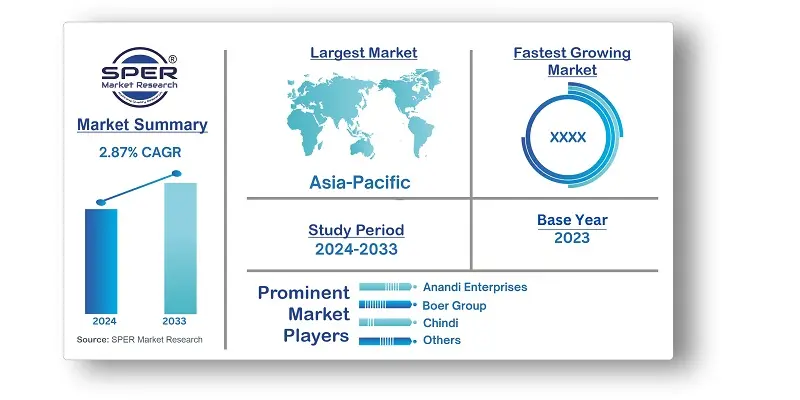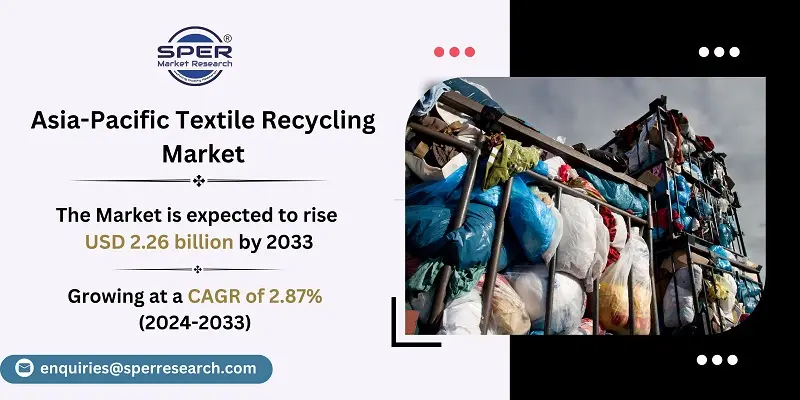
Asia-Pacific Textile Recycling Market Trends, Share, Demand, Size, Revenue and Future Outlook
Asia-Pacific Textile Recycling Market Growth, Size, Trends Analysis- By Product Type, By Textile Waste, By Distribution Channel- Regional Outlook, Competitive Strategies and Segment Forecast to 2033
| Published: Oct-2024 | Report ID: FMCG24166 | Pages: 1 - 156 | Formats*: |
| Category : Consumer & Retail | |||
- March 2022: An agreement was inked by HYOSUNG TNC and TOPTEN to team up on the formation of top-notch harmless to the ecosystem items.
- May 2023: Various governments took on another guideline on waste textiles. The guideline means to diminish how much textile waste going to landfill and burning by expanding how much material waste that is reused.


| Report Metric | Details |
| Market size available for years | 2020-2033 |
| Base year considered | 2023 |
| Forecast period | 2024-2033 |
| Segments covered | By Product Waste, By Textile Waste, By Distribution Channel |
| Regions covered | Australia, China, Indonesia, India, Malaysia, Philippines, South Korea, Thailand, Japan, Singapore, and the Rest of Asia-Pacific. |
| Companies Covered | Anandi Enterprises, Boer Group, Chindi, Hyosung Corporation, Khaloom Textile India Pvt. Ltd., Leign Fibers Inc., Martex Fiber Southern Corporation and Others |
- Textile Manufacturers
- Retail Brands
- Waste Management Companies
- Consumers
- Government and Regulatory Bodies
- Non-Governmental Organizations
| By Product Type: | |
| By Textile Waste: | |
| By Distribution Channel: |
- Asia-Pacific Textile Recycling Market Size (FY’2024-FY’2033)
- Overview of Asia-Pacific Textile Recycling Market
- Segmentation of Asia-Pacific Textile Recycling Market By Product Waste (Cotton Recycling, Wool Recycling, Polyester & Polyester Fibre Recycling, Nylon & Nylon Fibre Recycling and Others)
- Segmentation of Asia-Pacific Textile Recycling Market By Textile Waste (Pre-consumer Textile, Post-consumer Textile and Others)
- Segmentation of Asia-Pacific Textile Recycling Market By Distribution Channel (Online Channel, Retail & Departmental Stores)
- Statistical Snap of Asia-Pacific Textile Recycling Market
- Expansion Analysis of Asia-Pacific Textile Recycling Market
- Problems and Obstacles in Asia-Pacific Textile Recycling Market
- Competitive Landscape in Asia-Pacific Textile Recycling Market
- Impact of COVID-19 and Demonetization on Asia-Pacific Textile Recycling Market
- Details on Current Investment in Asia-Pacific Textile Recycling Market
- Competitive Analysis of Asia-Pacific Textile Recycling Market
- Prominent Players in Asia-Pacific Textile Recycling Market
- SWOT Analysis of Asia-Pacific Textile Recycling Market
- Asia-Pacific Textile Recycling Market Future Outlook and Projections (FY’2024-FY’2033)
- Recommendations from Analyst
1.1. Scope of the report1.2. Market segment analysis
2.1. Research data source
2.1.1. Secondary Data2.1.2. Primary Data2.1.3. SPER’s internal database2.1.4. Premium insight from KOL’s
2.2. Market size estimation
2.2.1. Top-down and Bottom-up approach
2.3. Data triangulation
4.1. Driver, Restraint, Opportunity and Challenges analysis
4.1.1. Drivers4.1.2. Restraints4.1.3. Opportunities4.1.4. Challenges
4.2. COVID-19 Impacts of the Asia-Pacific Textile Recycling Market.
5.1. SWOT Analysis
5.1.1. Strengths5.1.2. Weaknesses5.1.3. Opportunities5.1.4. Threats
5.2. PESTEL Analysis
5.2.1. Political Landscape5.2.2. Economic Landscape5.2.3. Social Landscape5.2.4. Technological Landscape5.2.5. Environmental Landscape5.2.6. Legal Landscape
5.3. PORTER’s Five Forces
5.3.1. Bargaining power of suppliers5.3.2. Bargaining power of buyers5.3.3. Threat of Substitute5.3.4. Threat of new entrant5.3.5. Competitive rivalry
5.4. Heat Map Analysis
6.1. Asia-Pacific Textile Recycling Market Manufacturing Base Distribution, Sales Area, Product Type6.2. Mergers & Acquisitions, Partnerships, Product Launch, and Collaboration in Asia-Pacific Textile Recycling Market
7.1. Asia-Pacific Textile Recycling Market Size, Share and Forecast, By Product Type, 2020-20267.2. Asia-Pacific Textile Recycling Market Size, Share and Forecast, By Product Type, 2027-20337.3. Cotton Recycling7.4. Wool Recycling7.5. Polyester & Polyester Fibre Recycling7.6. Nylon & Nylon Fibre Recycling7.7. Others
8.1. Asia-Pacific Textile Recycling Market Size, Share and Forecast, By Textile Waste, 2020-20268.2. Asia-Pacific Textile Recycling Market Size, Share and Forecast, By Textile Waste, 2027-20338.3. Pre-consumer Textile8.4. Post-consumer Textile8.5. Others
9.1. Asia-Pacific Textile Recycling Market Size, Share and Forecast, By Distribution Channel, 2020-20269.2. Asia-Pacific Textile Recycling Market Size, Share and Forecast, By Distribution Channel, 2027-20339.3. Online Channel9.4. Retail & Departmental Stores
10.1. Asia-Pacific Textile Recycling Market Size and Market Share
11.1. Asia-Pacific Textile Recycling Market Size and Market Share By Region (2020-2026)11.2. Asia-Pacific Textile Recycling Market Size and Market Share By Region (2027-2033)11.3. Australia11.4. China11.5. Indonesia11.6. India11.7. Malaysia11.8. Philippines11.9. South Korea11.10. Thailand11.11. Japan11.12. Singapore11.13. Rest of Asia-Pacific
12.1. Anandi Enterprises
12.1.1. Company details12.1.2. Financial outlook12.1.3. Product summary12.1.4. Recent developments
12.2. Boer Group
12.2.1. Company details12.2.2. Financial outlook12.2.3. Product summary12.2.4. Recent developments
12.3. Chindi
12.3.1. Company details12.3.2. Financial outlook12.3.3. Product summary12.3.4. Recent developments
12.4. Hyosung Corporation
12.4.1. Company details12.4.2. Financial outlook12.4.3. Product summary12.4.4. Recent developments
12.5. Khaloom Textile India Pvt. Ltd
12.5.1. Company details12.5.2. Financial outlook12.5.3. Product summary12.5.4. Recent developments
12.6. Leign Fibers Inc
12.6.1. Company details12.6.2. Financial outlook12.6.3. Product summary12.6.4. Recent developments
12.7. Martex Fiber Southern Corporation
12.7.1. Company details12.7.2. Financial outlook12.7.3. Product summary12.7.4. Recent developments
12.8. Others
SPER Market Research’s methodology uses great emphasis on primary research to ensure that the market intelligence insights are up to date, reliable and accurate. Primary interviews are done with players involved in each phase of a supply chain to analyze the market forecasting. The secondary research method is used to help you fully understand how the future markets and the spending patterns look likes.
The report is based on in-depth qualitative and quantitative analysis of the Product Market. The quantitative analysis involves the application of various projection and sampling techniques. The qualitative analysis involves primary interviews, surveys, and vendor briefings. The data gathered as a result of these processes are validated through experts opinion. Our research methodology entails an ideal mixture of primary and secondary initiatives.



Frequently Asked Questions About This Report
PLACE AN ORDER
Year End Discount
Sample Report
Pre-Purchase Inquiry
NEED CUSTOMIZATION?
Request CustomizationCALL OR EMAIL US
100% Secure Payment






Related Reports
Our Global Clients
Our data-driven insights have influenced the strategy of 200+ reputed companies across the globe.




















